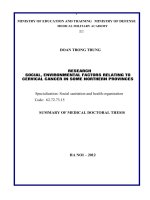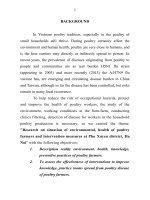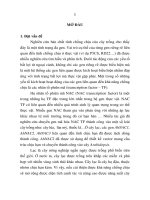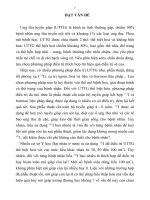TÓM tắt LUẬN án (TIẾNG ANH) nghiên cứu hiệu quả bổ sung sản phẩm giàu acid amin và vi chất dinh dưỡng (viaminokid) cho trẻ 1 3 tuổi suy dinh dưỡng thấp còi
Bạn đang xem bản rút gọn của tài liệu. Xem và tải ngay bản đầy đủ của tài liệu tại đây (424.55 KB, 28 trang )
MINISTRY OF EDUCATION & TRAINING
MINISTRY OF HEALTH
HANOI MEDICAL UNIVERSITY
NGUYEN THI THUY HONG
STUDY ON EFFECTIVENESS OF AMINO
ACIDS AND MICRONUTRIENTS (VIAMINOKID)
SUPPLEMENTATION FOR CHILDREN AGED
1-3 YEARS OLD WITH STUNTING
Specialized : Pediatrics
Code
: 62720135
SUMMARY OF DOCTORAL THESIS
HÀ NỘI - 2018
THE THESIS IS COMPLETED IN HANOI UNIVERSITY
Supervisor:
1. Ass Prof. PhD. MD. Nguyen Thi Lam
2. Ass Prof. PhD. MD. Nguyen Thi Yen
Reviewer 1:
Prof. PhD. MD. Le Thi Huong
Reviewer 2:
Ass Prof. PhD. MD. Nguyen Thi Phuong
Reviewer 3:
Prof. PhD. MD. Le Thi Hop
The thesis will be protected at the Board of University doctoral thesis
evaluation at the Hanoi Medical University:
At the time of day
month
year
The contents of the thesis can be found at:
- National Library of Vietnam
- Library of Hanoi Medical University
- Library of Central Medical Information
1
INTRODUCTION
Stunting and micronutrient deficiencies in children under 5 years old
are significant public health concern. Lack of micronutrients influences the
development of the mind, the physique, the physiology of children. As a
consequence, not only does the child become stunting or underweight but also
reduces the ability to learn, increases the risk of illness and death. Lack of
protein and minerals are closely related to nutrition status. When children
do not eat enough in quantity and quality of protein and minerals will
reduce immunity, contributing to increasing the frequency of infections
such as diarrhea, respiratory infections in children.
In the world, there are many studies that intervene in multicenter
supplementation for stunted children. However, in our country, few
studies have evaluated the effect of amino acids and micronutrient
supplementation for stunted children. Therefore, we proceed with the
topic: "Study on effectiveness of Viaminokid supplementation for
children aged 1-3 years old with stunting" with the following
objectives:
1. Evaluate the efficacy of Viaminokid supplementation for growth status
in children aged 1-3 years old with stunting after intervention.
2. Evaluation of changes blood biochemical parameters: Hemoglobin,
ferritin, serum IGF-1, IgA in children aged 1-3 years old with stunting
after supplemental intervention Viaminokid.
3. Evaluate the effectiveness of Viaminokid interventions for the
frequency of respiratory infections and diarrhea in children aged 1-3
years old with stunting after intervention.
1. Necessity of the research
In the world, many studies have intervened to supplement nutritional
products for stunted children. In Vietnam, recent studies that have
intervened for children with stunting at community as micronutrient
supplements (calcium, iron, zinc, vitamin A, vitamin D). However, these
interventions were mainly focused on the use of multiple micronutrients
without any intervention in the efficacy of essential amino acids and
2
micronutrients for children with stunting. Thus, intervention by
supplementation of amino acids and micronutrient supplementation may
be effective measures to break the chain of twists associated with
malnutrition and disease. Based on the actual needs, Viaminokid products
contain essential amino acids and micronutrients meeting 30 - 50% of
daily needs is necessary for stunted children, especially for children in
remote areas, especially difficult areas.
2. New contributions of the thesis
This is the first intervention study in Vietnam on nutritional products
supplemented with essential amino acids and micronutrients for stunted
children. Research has provided scientific evidence to confirm that in
addition to the role of micronutrients, the addition of amino acids is
essential for stunted children. In fact, that lack of protein in children's
diets in rural and mountainous areas is quite common.
The research has evaluated the effect of products with amino acids
and micronutrients rich (Viaminokid) in improving the anthropometric
indicators, blood biochemical parameters as well as immunization status
for stunted children. Stunting was halved compared with preintervention. Similarly, iron deficiency was reduced by 18%, zinc
deficiency was 46.2% lower than pre-intervention. The IGF-1 growth
rate and immunological index were also significantly improved in the
intervention group. In addition, the respiratory infections disease and
digestive diseases (diarrhea, anorexia) have also been significantly
improved.
3. Thesis structure.
The thesis is presented in 128 pages. In addition to the introduction
(3 pages), the conclusion (2 pages) and the recommendation (1 page),
there are 4 chapters including: Chapter 1: Literature review (38 pages);
Chapter 2: Methodology (21 pages); Chapter 3: Results (32 pages);
Chapter 4: Discussion (31 pages). The thesis has 27 tables, 8 figures, 17
charts, 139 references (Vietnamese: 35; English: 104).
Chapter 1
LITERATURE REVIEW
3
1.1. Stunting overview.
In the world
Analysis of data on 576 surveys in 148 developed and developing
countries showed that the number of stunted children has decreased from
253 million (1990) to 171.4 million (2010), which is expected to
decrease to 142 million by 2020.
In Vietnam
In Vietnam, despite many achievements in the prevention of
malnutrition, the prevalence of stunted children in our country is still
high. In particular, the period of highest risk of stunting was from 12-24
months old and remained high for up to 60 months.
35
30
25
20
15
29,3
18,8
Mild stun ng
Moderate stun ng
Severe stun ng
27,5
26,7
25,9
24,9
24,6
16,1
16,4
15,2
16,4
9,5
9,7
2013
2014
10,5
11,4
15,5
11,2
2010
2011
2012
10
8,2
5
0
2015
Figure 1.1. The situation of stunted children under 5 years old in
Vietnam
1.2. The situation of amino acids and micronutrient deficiencies and
interventions
In the world
In developing countries, the diets of households are mainly cereals.
As a result, deficiency of essential amino acids and micronutrients is also
common. Therefore, amino acid supplementation in food has also been
implemented in many countries. Recently, a combined study of 18
4
intervention trials (2017) in children aged 6-35 months found that protein
supplements improved growth both weight and height for stunted
children.
In addition, micronutrient deficiencies in developing countries are
high. Currently, around 2 billion people worldwide are at risk of multiple
micronutrient deficiencies. It is estimated that around 17.3% of the world
population is at risk of zinc deficiency, 600-700 million people in iron
deficiency anemia. Recent research by Shafique (2016) on the effects of
micronutrient supplementation in 6 months for 467 low birth weight
infants in Bangladesh has shown that the prevalence of stunting in the
supplemented children was significantly lower than in the control group.
In Vietnam
According to the National Institute of Nutrition (2015), the
prevalence of anemia in children under 5 years old is 27.8%. The
research by Tran Thi Nguyet Nga (2017) on 263 children aged 12-36
months showed that the prevalence of vitamin D deficiency was high
(44.1-56.8%).
There were many studies on the efficacy of nutritional supplements
such as lysine and micronutrient supplement for children aged 6-12
month old by Nguyen Thi Hai Ha (2012). Similarly, research by Tran
Thuy Nga (2015) on the efficacy of multivitamin supplementation has
shown a significant improvement in zinc deficiency, iron deficiency, and
nutritional status.
1.3. The role of amino acids and micronutrients in stunted children.
1.3.1. The role of amino acids in immune function and growth.
In children, the assimilation process strongly takes place, the role of
the amino acids is extremely essential. There are four essential amino
acids or deficiencies in the diet: lysine, threonine, tryptophan and
methionine. Therefore, when children do not eat enough in quality and
quantity of protein can be reduced the immunity, contributing to
increasing the frequency of infections. In addition, protein deficiency is
also closely related to stunting.
1.3.2. Effect of GH/IGF-1 hormone on growth in children.
5
In recent years, more and more studies have examined the role of
GH/IGF-1 in the growth and development of children. Many studies
show that lack of energy protein deficiency, zinc deficiency reduces the
process of IGF-1 biosynthesis from the liver. Serum IGF-1 levels were
closely correlated, linear with the Z-score (WA, HW). Children with WAZ or
HAZ less than -2SD had significantly lower IGF-1 levels than those with
WAZ or HAZ greater than -2SD.
G H R H v s , S M S (tă n g ) c â n b ằ n g
T iế t G H ( g i ả m )
G H b á m v à o th ụ th ể G H R
( g iả m )
T r u y ề n t h ô n g t i n s a u G H g iả m h ạ n c h ế p r o t e in
B iể u h iệ n g e n IG F - 1 ( g iả m )
V ậ n c h u y ể n G F - 1 k ế t h ợ p v ớ i p r o t e in ( g i ả m )
T h ả i tr ừ IG F - 1 ( tă n g v ậ n c h u y ể n p r o te in )
IG F - 1 n g o ạ i b iê n
( g iả m )
(g ia m )
N ồ n g đ ộ IG F - 1 ( g iả m )
IG F -1 g ắ n k ế t tự d o v ớ i IG F -1 R g iả m
Chart 1.1. Summary of abnormalities in the GH-IGF-1 axis caused by
protein-calorie malnutrition
1.3.3. The role of micronutrients in immune function and growth in
stunted children
Recent studies have shown that children with stunting often lack
many micronutrients such as vitamin A, vitamin D, iron, zinc, calcium,
selenium, etc.
Zinc is a necessary cofactor for the activity of many enzymes and
hormones. Zinc deficiency leads to reduce the function of most immune
cells, including T-cells, B-cells and macrophages and increasing the risk
of infection. In addition, iron's role in growth and immunity has been
documented in many studies. Iron deficiency of the immune response
6
decreases and affects the activity of macrophages. Similarly, calcium also
has an important role, especially during the growth of children. If
calcium is not adequately provided, it will affect the growth of the
skeleton resulting in rickets, stunting. At present, the role of selenium is
becoming more and more known. Selenium is a micronutrient, essential
for antioxidant activity to protect cell membranes and cell nuclei from
damage. Furthermore, selenium also has an important role in the growth
and development of the body.
In addition to the role of the vitamins are also important. Vitamin A
is one of the vitamins that have an essential role in the body's immune
system. The role of vitamin D is enrolled to activate a non-specific immune
system and decreasing the specific immune system. Vitamin D deficiency is
associated with increasing risk of influenza virus infection and acute
respiratory infections in children. Furthermore, vitamin D has important
role in the growth of height in children. Other micronutrients are also
known for growth and immunity, such as iodine, folic acid, B vitamins,
etc.
Chapter 2
METHODOLOGY
2.1. Location and time
2.1.1.
Location: Tan Hoa and Giap Son Village, Luc Ngan district, Bac
Giang province.
2.1.2.
Time: From 2011 September to 2013
2.2. Subject: Children from 1-3 years old living in 2 communes (Tan
Hoa and Giap Son) at Luc Ngan district, Bac Giang province.
2.2.1. Selection Criteria
- Stunted children with Z-score height/weight < - 2 (criteria WHO, 2006).
- Without any chronic disease or birth defects.
- Not using any micronutrients supplementations.
- Agreement of the family to let the child participate in the study.
2.2.2. Exclusion criteria
7
-
The baby has a history of preterm birth, low birth weight <2500
grams, fetal preterm.
- Severe anemia (Hb < 6 g/dl).
- Children who use less than 70% of products at the end of the study
- Children have been involved in another nutritional use trial.
2.3. Study design
2.3.1. Study design
Community intervention trial, randomized controlled patients and
pre - post intervention assessment.
2.3.2. Sample size
Use the formula for intervention trial to assess the mean difference
between two study groups at the end of the intervention.
2 x [(Z(1-α/2) + Z(1-β)) ] 2
n=
µ1 - µ2
Sample size for Z-score: Estimated difference between disease
group and control group for Z-score: μ1-μ2 = 0.5 cm; = 0.95; n = 76
children/group. Sample size for difference in IgA concentration: μ1-μ2 =
0.5 mg/mL; = 1,3; n = 71 children/group. After calculation, the sample
size was 76 children/group, plus 20% of children who maybe give up.
Thus, there will be 90 children/group, the total number of subjects of the
two groups is 180 children.
2.3.3. Sample size technique.
Step 1: Choose village and district
- Choose district: Luc Ngan district of Bac Giang.
- Choose village: Select 2 villages with similar economic conditions and
living standards
Step 2: Sample technique
Use the multi-stage sampling method:
- Screening of children with stunting: In each village, make a list of
children from 1-3 years old meet the above criteria.
- Targeted subjects: Stunted children met all the criteria.
8
- Paired: The total number of stunted children in the 2 villages is
divided into 3 age groups, suitable for age group and sex (Group 1: 12-23
months, group 2: 24-35 months, group 3: 36-47 months).
Step 3: Group:
- Group 1 (Intervention group): Normal diet with viaminokid in 9 months.
- Group 2 (Control group): Normal diet with placebo in 9 months
2.3.4. Study process.
2.3.4.1. Subject investigation.
-
Screening: Over 796 children from 1-3 years old living in 2 villages
(Tan Hoa and Giap Son), we selected 220 children with stunting. After
screening, 184 stunted children were eligible.
- The first survey (T0): Conducted with 184 eligible children.
- During the intervention period (T 0-T9): During 9 months of
intervention, 24 children were not eligible for the intervention. Therefore,
the results were analyzed in 160 infants (control group with 80 children
and intervention group with 80 children).
- After 6 months after interventional time (T 15), 24 children were
excluded from the study. Thus, the data after 6 months of intervention
was analyzed on 136 children.
2.3.4.2 Selection and training of staff involved in the study
Select collaborators and supervisors.
- 2 collaborators / 1 village.
- The whole process of research was supervised by 2 central supervisors (1
supervisors were Hanoi Medical University researcher, 1 supervisor of
nutritional institute) and supervisor of Luc Ngan district’s medical center.
Training for supervisors and collaborators and caregivers.
2.3.4.3. Intervention
- Intervention group: Viaminokid (2 packs per day).
- Control group: Children are given Pacebo (2 packs per day). At the
end of the study, the control group will receive 3 months free
Viaminokid.
Single blind in research: Collaborators, mothers do not know the
nature of the two types of products. The product is presented in the oral
9
packaging as Viaminokid. Collaborators, mothers only identified
Viaminokid (Viaminokid 1) and Placebo (Viaminokid 2) via the name
with numbers 1 and 2.
Viaminokid and Placebo components:
*) Viaminokid (For intervention group with the name is Viaminokid 1):
The main ingredients are Swiss yeast amino acids and Danish premixes:
5 amino acids (lysine, threonine, arginine, methionine, taurin), 8 vitamins
(A, D, E, B1, B3, B6, B9, B12) và 6 minerals (sắt, kẽm, selen, iod, canxi,
mangan).
*) Placebo (For control group with the name is Viaminokid 2): The main
ingredient is glucose and lactose, with the sweet smell of milk.
*) Viaminokid and Placebo: The Nutrition Center of the National
Institute of Nutrition Research, in collaboration with the Hai Duong
Pharmaceutical Products HADUPHACO production, has been tested on
the safety and acceptability of children. Post-production products are
randomly checked for product quality.
2.3.5. Method of data collection and assessment criteria
The information collected included: General information on
demographics, diet, anthropometric indicators, disease status and test
indices at T0, T5, T9 and after stopping the intervention (T15)
Indicators of anthropometry
- Weight, height: weighing method, based on WHO technique, 2006.
- Age based on WHO criteria (2006).
- Classification of nutritional status of children according to WHO (2006):
Children were assessed as malnutrition when WAZ, HAZ, WHZ < -2SD.
Disease index
Diagnosis criteria for diarrhea and acute respiratory infections are in
accordance with the guidelines of the Integrated Management of
Children Infection (IMCI).
- Respiratory infections: Children are diagnosed with acute respiratory
syndrome when they have cough, fever, runny nose, shortness of breath,
rapid breathing (≥40 times / minute).
- Diarrhea: Children are considered to be diarrhea when they have loose
stools or have blood stool ≥ 3 times a day. The duration of diarrhea <14
10
days was diagnosed as acute diarrhea, > 14 days was prolonged diarrhea,
if bloody mucus in the stool is dysentery.
- Picky eating: 1) Refuse to eat (do not eat 2 meals a day) or take long
food in mouth (over 30 minutes/meal); 2) Do not eat half the amount of
food compared to the age (one day); 3) Oral intake > 1/2 the amount of
food, but due to force to eat and over time eat (over 30 minutes).
Test indicators
Tests carried out in Micronutrients Department of the National
Institute of
and Medlatec Hospital. Test parameters are assessed
according to WHO criteria:
- Hb: When blood hemoglobin levels <110 g/L: anemic.
- Serum ferritin: When concentrations <12 μg/L: iron deficiency.
-Serum zinc: When the concentration is <10.7 μmol/L: zinc deficiency.
-Serum IgA: When concentration <70 mg/dL: reduced.
-IGF-1: When concentration <50 ng/mL: reduced.
Data processing and analysis
Data was entered by EPIDATA software. Anthropometric data was
processed by WHO Anthro software, 2006. All data were analyzed by
using SPSS 16.0 software. Tests (χ 2 test, test t-pair, Mann-Whitney test,
Fisher exact test) are appropriately selected to ensure accuracy.
2.3.8. Ethics
The study was approved by the Ethics Council of the National
Institute of Nutrition. Parents are informed about the purpose, rights and
responsibilities of participating in the study and voluntarily participate in
the study. The study participants received nutritional counseling before
intervention.
Chapter 3
RESULTS
11
3.1. GENERAL INFORMATION
The study was conducted in two communes (Tan Hoa and Giap
Son). 796 children aged 1-3 years old were screened, 184 stunted
children were eligible to participate in the study, and 24 were excluded
from the study. Therefore, the results of the study were evaluated on 160
children (control group 80 children and intervention group 80 children).
Similarly, after 6 months of stopping intervention, 24 children were
excluded, so data were analyzed on 136 children
3.1.1. Demographic characteristics of the participants
- The main occupations of mothers are farming and forestry.
- The average age of the subjects was 29,1 ± 9,6 (months).
- The prevalence of stunted children in boys was 56.2%, in girls was
43.8%.
3.1.2. Nutritional status and biochemical index of children at the time
of initiation of intervention (T0).
- There was no difference in the anthropometric index as well as
nutritional status between the two groups at baseline (p>0.05).
- Similarly, there were no differences in blood biochemical parameters
(iron, zinc, IgA, IGF-1) between the two groups.
12
3.2.
EFFICIENCY
OF
INTERVENTION
ON
ANTHROPOMETRIC INDICATORS
3.2.1. Efficiency of intervention after 9 months (T0-T9)
Table 3.1. Efficacy on anthropometry
Variable
Weight
(kg)
Height
(cm)
THE
Control Group
Intervention Group
(n=80)
(n=80)
T0
10,29 ± 1,91
10,30 ± 1,63
>0,05
T5
10,75 ± 1,62
11,23 ± 1,46
<0,05
T9
11,61 ± 1,61
12,09 ± 1,50
<0,01
T0-T5
0,40 ± 1,05
0,79 ± 1,02
<0,05
T0-T9
1,32 ± 0,93
1,78 ± 1,22
<0,05
T0
81,04 ± 6,42
81,10 ± 6,42
>0,05
T5
84,72 ± 6,13
85,09 ± 6,11
<0,01
T9
87,98 ± 6,04
89,43 ± 5,58
<0,01
T0-T5
3,42 ± 1,20
3,94 ± 2,18
>0,05
Time
p*
T0-T9
6,94 ± 1,54
7,85 ± 2,15
<0,05
*) Mann-Whitney test.
Values expressed as median SD
The table shows that intervention group with mean weight gain (1.78
± 1.22 kg) was significantly higher than control group (1.32 ± 0.93 kg)
with p<0.05. Similarly, the mean height increase in the intervention
group (7.85 ± 2.15 cm) was also significantly higher than in the control
group (6.94 ± 1.54 cm).
13
Variable
Table 3.2. Change the Z-score
Control group Intervention group
Time
(n=80)
(n=80)
Weight/Age (WAZ)
Height/Age (HAZ)
Weight/Height (WHZ)
T0
T5
T9
T0-T5
T0-T9
T0
T5
T9
T0-T5
T0-T9
T0
T5
T9
T0-T5
T0-T9
- 1,84 ± 0,88
- 1,88 ± 0,71
- 1,80 ± 0,64
- 0,05 ± 0,69
0,04 ± 0,61
- 2,68 ± 0,54
- 2,58 ± 0,56
- 2,46 ± 0,65
0,09 ± 0,33
0,22 ± 0,42
- 0,65 ± 0,86
- 0,62 ± 0,82
- 0,58 ± 0,72a
0,02 ± 0,81
0,07 ± 0,75
- 1,78 ± 0,91
- 1,65 ± 0,64*,a
- 1,55 ± 0,79*,b
0,13 ±0,75
0,25 ± 0,87
- 2,65 ± 0,53
- 2,39 ± 0,60*,a
- 2,30 ± 0,56 *,a
0,28 ± 0,65*
0,39 ± 0,35**
- 0,61 ± 0,79
- 0,54 ± 0,68
- 0,44 ± 0,84a
0,05 ± 0,83
0,18 ± 0,93
*, p<0,05, **,p<0,01 compared with the control group (Mann-Whitney test).
a
, p<0,05; b, p<0,01; comparison before and after the intervention of the same
group (t-test-pair).
Values expressed as median SD
The table demonstrates that after 9 months of intervention, the Zscore changed significantly in all groups. The HAZ score in the
intervention group (0.39 ± 0.35) was significantly higher than in the
control group (0.22 ± 0.42) with p<0.05. Similarly, the WAZ-score in the
intervention group (0.25 ± 0.87) was also higher than the control group
(0.04 ± 0.61) with p<0.05.
3.2.2. Effective after 6 months of stopping intervention (T9-T15)
14
Intervention Group
Control Group
Figure 3.1. Effective on the rate of stunting.
The figure illustrates that the prevalence of stunting has been
significantly reduced through intervention periods. After 9 months of
intervention, the prevalence of children with stunting was reduced to 60% and
after 6 months of stopping intervention, stunting was reduced by half (50%).
3.3.
EFFICIENCY OF INTERVENTION
ON
BLOOD
BIOCHEMICAL PARAMETERS
3.3.1. Effective after 9 months of intervention (T0-T9)
Intervention Group
Control Group
Anemia
Iron Deficiency
Zinc Deficiency
Figure 3.2. The rate of anemia, iron deficiency and zinc deficiency.
The results indicate that after 9 months of intervention, anemia, iron
and zinc deficiencies were significantly improved in the intervention
group, statistically significant differences with p<0.05.
Table 3.3. Changes in IgA and IGF-1 levels
Variable
Time
Control group
Intervention group
15
IgA
(mg/dL)
IGF-1
(ng/mL)
T0
T5
T9
T0-T5
T0-T9
T0
T9
T0-T9
(n = 80)
80,6 ± 35,9
83,7 ± 45,0
81,9 ± 31,8
2,30 ± 37,09
0,91 ± 25,45
84,6 ± 37,6
95,0 ± 25,4
9,23 ± 37,82
(n = 80)
79,8 ± 33,7
94,2 ± 41,8 a
90,7 ± 29,5 a
13,08 ± 34,37
13,06 ± 33,69 *
81,9 ± 34,3
110,0 ± 26,2 a
26,48 ± 35,73**
*, p<0,05, **,p<0,01 compared with the control group (Mann-Whitney test).
a
, p<0,05, comparison before and after the intervention of the same group (t-test
pairing).
The table demonstrates that IGF-1 levels were significantly
improved in the intervention group (110.0 ± 26.2 ng/mL) compared with
control group (95.0 ± 25.4ng/mL) after 9 months of intervention.
Similarly, IgA concentration of the intervention group tended to increase
more than the control group, but the difference was not statistically
significant.
3.3.2. Effective after 6 months of stopping intervention (T9-T15)
Control Group
Intervention Group
Figure 3.3. Effective in reducing iron deficiency.
The figure shows that after 6 months of stopping intervention, the
reduction in iron deficiency was maintained in the intervention group of
47.7%, compared with 37.4% in the control group (p<0.05).
16
%
Control Group
Intervention Group
Figure 3.4. Effective in reducing the rate of IgA and IGF-1
deficiencies.
The figure illustrates that effective in reducing IGF-1 deficiency was
maintained at a high level in the intervention group (41.3%), while the
control group was 2% (p<0.05). Similarly, IgA deficiency in the
intervention group was 23.6% higher than in the control group with 2%.
3.4. EFFICIENCY OF INTERVENTION ON DISEASES STATUS
3.4.1. Efficiency of intervention for respiratory infections after 9
months of intervention.
Control Group
Intervention Group
Normal
1 Time
2 Times
≥ 3 Times
Figure 3.5. Frequency of respiratory infections.
17
The figure gives the information about the percentage of children
who did not have acute respiratory infections in the intervention group
was significantly higher than in the control group (56.2% and 36.2% with
p<0.05). Frequency of acute respiratory infections > 2 times during 9
months intervention was significantly reduced in intervention group
compared with control group (p<0.05).
3.4.2. EFFICIENCY OF INTERVENTION ON DIGESTIVE
DISEASE AFTER 9 MONTHS OF INTERVENTION
%
Normal
1 Time
Control Group
≥ 2 Times
Intervention Group
Figure 3.6. Frequency of acute diarrhea
The results illustrate after 9 months of intervention, the number
of children without diarrhea in the intervention group was significantly
higher than the control group (85.0% compared with 67.5%, p<0.05).
Similarly, the frequency of diarrhea was also significantly reduced in the
intervention group compared to the control group.
18
%
Control Group
Intervention Group
Figure 3.7. Picky eating status
According to the figure above, picky eating in the intervention group
was significantly improved, with 56.3% of children reduced to 22.5%
after 9 months of intervention and maintained at 20.6% after 6 months of
stopping intervention.
Chapter 4
DISCUSSION
4.1. NUTRITIONAL STATUS AND BLOOD BIOCHEMICAL
PARAMETERS OF CHILDREN AT THE BEGINNING OF THE
RESEARCH (T0)
4.1.1. Nutritional status of children at time T0.
The mean age of children in the study group was 29.1 ± 9.6
(months). The prevalence of malnutrition in boys was 56.2%, 43.8%
more than girls. There was no difference between the age groups of
children in the study group. Similarly, the prevalence of malnutrition in
the two study groups was similar: 100% of stunting and underweight
with range 35% - 41.3%.
19
4.1.2. Blood biochemical parameters at time T 0.
There was no difference in hemoglobin, ferritin, serum zinc levels,
IGF-1 growth factor as well as IgA immune indices between the
intervention groups and the control group (p>0.05). Iron and zinc
deficiency in stunted children is high (>50%). This proportion is higher
in our study than in other regions due to participants were stunted
children. In addition, the age of participants was 1-3 years, this is the
period of the strongest child, which is easily affected by unbalanced
nutrition.
4.2. EFFICIENCY OF INTERVENTION AFTER 9 MONTHS OF
INTERVENTION
4.2.1. Efficiency of intervention on the anthropometric indicators
After 9 months of intervention, the weight of children in both control
and intervention groups increased, but the median weight of the
intervention group was 12.09 ± 1.50 kg higher than that of the control
group with 11.61 ± 1.61 kg (p<0.01). Similarly, median height of
intervention group (89.43 ± 5.58 cm) was higher than control group
(87.98 ± 6.04 cm) (p <0.01). Specifically, the median height increase in the
intervention group was significantly higher (7.85 ± 2.15 cm) than the control
group (6.94 ± 1.54 cm) with p<0.05 . As a result, the rate of stunting in the
intervention group was halved (50%) after 9 months of intervention, this
rate in control group was 25%.
Thus, the weight and height index as well as the Z-score in stunted
children were significantly improved after 9 months of intervention. The
direct impact of Viaminokid on the nutritional status of stunted children
in the study is clear. Because, in addition to providing amino acids
components, there is sufficient presence in the number of ingredients
such as calcium, phosphorus, iron, zinc, selenium, iodine, vitamin A,
vitamin D3, vitamins B1, B3, B6, B12 contribute to the children's diet. In
addition, amino acids, vitamins and minerals are involved in most of
20
metabolism of the body. The indirect effect of micronutrients that it
contributes to stimulating appetite of children. Therefore, the amount of
food to eat as well as the amount of protein is provided more rapid
impact on the growth of children. In addition, stunted children often lack
micronutrients at the same time, combined with a poor diet, nutrient
deficiency, chronic energy deficiency so multiple micronutrients and
amino acids supplements are needed for optimum growth.
4.2.2. Efficiency of intervention on blood biochemical parameters
Changes in the Hemoglobin index and the prevalence of anemia
and iron deficiency
Results of our study showed that the median Hb concentration after
9 months of intervention increased significantly (123.4 ± 11.1 g/L)
compared to baseline T0 (108.8 ± 114 g/L) and higher than control group
(117.5 ± 10.7 g/L) with p<0.05. Similarly, the prevalence of anemia was
reduced by 31.3%, iron deficiency by 18.8%. Thus, supplemental
Viaminokid is able to recover anemia, iron deficiency of children with
stunting. The improvement in blood hemoglobin levels in this study may
be due to the presence of iron, vitamin B12 and amino acids. Because
these nutrients that contribute to the blood-forming process.
Changes in serum zinc levels and the prevalence of zinc
deficiency
After 9 months of intervention, serum zinc level in the intervention
group (12.0 ± 1.4 μmol/L) was significantly higher than serum zinc level
(10.7 ± 2.0 μmol/L) with p<0.05. Similarly, the reduction of the rate of
zinc deficiency in the intervention group (46.2%) was higher than the
control group (12.5%). This can be explained by the addition of high
zinc, Viaminokid also provides additional trace elements and essential
amino acids for better absorption of zinc. Our results fit with research by
Nguyen Thanh Ha (2012), Tran Thi Lan (2013): Multiple micronutrients
supplementation in stunted children improves serum zinc levels as well
as inadequate zinc.
21
Changes in IGF-1 growth index
IGF-1 levels were significantly higher in the intervention group
(110.0 ± 26.2 ng / mL) compared with control group (95.0 ± 25.4 ng/mL)
with p<0.05. The reason for this, Viaminokide are essential amino acids
and micronutrients (zinc, selenium, iodine), especially the role of zinc.
Zinc is an indispensable catalyst of RNA polymerase, which plays an
important role in DNA duplication and protein synthesis. Our results are
also consistent with research by Nguyen Xuan Ninh.
Changes in the IgA immune index
Intervention effectiveness for IgA was not clear, but changes in IgA
levels tended to increase after 9 months of intervention. IgA levels in the
intervention group (90.7 ± 29.5 mg/dL) were significantly higher than the
control group (81.9 ± 31.8 mg/dL). However, the difference was not
statistically significant (p>0.05). This can be explained by the fact that
amino acids and micronutrients contribute directly to the regulation and
increase the immunity of the body. In addition, the addition of other
nutrients such as vitamins A, D, zinc, selenium in Viaminokid is also
effective in enhancing immune system.
4.2.3. Efficiency of intervention on disease status
Efficiency of intervention for respiratory disease:
Up to 56.2% of children who did not have respiratory infections during
the intervention period. Thus, supplementation with Viaminokid has been
effective in reducing the incidence and frequency of respiratory
infections in stunted children. Because, Viaminokide with zinc, selenium,
vitamins A, D and amino acids have a positive effect on the function and
recovery of the epithelium and system of organs in the body to reduce the
risk of infection. When children do not eat enough in quantity and quality
of protein and micro minerals can be reduced the immunity, contributing
to increasing frequency of infections, especially in children with
respiratory infections.
22
Efficiency of intervention for digestive disease:
Gastrointestinal status improved significantly after 9 months of
intervention. There were 85% of children who had no diarrhea during the
intervention period. At the same time, the percentage of diarrhea in the
control group was 23.8%, while in the intervention group was 13.8%. It
is probably due to Viaminokide has a high content of zinc, vitamin A and
micronutrients that help maintain the integrity of intestinal and epithelial
cells. By promoting the growth of cells that help protect cells, against the
destruction of free radicals in inflammatory responses, preventing
diarrhea.
Efficiency of intervention for picky eating status
Our results show that 56.3% of children have anorexia, after 9
months of intervention has decreased to 22.5%. Meanwhile, this rate in
the control group was slightly reduced from 58.8% to 43.8%. This can be
explained by the fact that the supplement contains lysine and zinc which
stimulates appetite.
4.3. EFFICIENCY OF INTERVENTION AFTER 6 MONTHS OF
INTERVENTION
4.3.1. Efficiency of intervention on the anthropometric indicators
Effectiveness of Viaminokid interventions on weight index, as well
as Z-score, was maintained and persisted after 6 months of intervention.
The increase in cumulative height in the intervention group was higher
than the control group with 1.22 cm. Similarly, there was a significant
change in the increase in the Z-score of height/weight and the decrease in
the rate of stunting at intervals. This suggests that interventions to
supplement amino acids and micronutrients take long enough to promote
the effects of micronutrients because stunted children have severe
nutritional deficiencies status.
4.3.2. Efficiency of intervention on blood biochemical parameters









